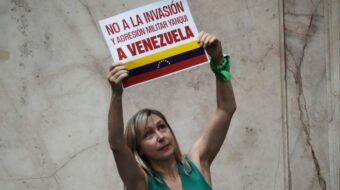Until recently, the United States has operated 22 U.S. military bases in Latin America, 800 worldwide. Now there are two more, one in Chile and another in Argentina, the first in either country. The purported justification is humanitarian.
U.S. diplomats and Chilean military chiefs gathered April 5 at the Fort Aguayo naval base in Concón, 90 miles northwest of Santiago, Chile’s capital, to inaugurate a recently completed eight-building complex intended as a training prop for mock urban battles. The U.S. military’s Southern Command provided $460,000 for construction. Training will be consistent with U.S. military doctrine known as Military Operations on Urbanized Terrain (MOUT).
Opening ceremonies took place even as U. S. and Chilean military personnel were teaching 300 junior level military and police personnel from 17 countries. The course there covers police training, convoy movements, crowd control, and helicopter tactics. Students are being prepared ostensibly to deal with natural disasters or national emergencies, specifically for United Nations “Peacekeeping Operations.” Joint Chilean and U.S. military experience in post-earthquake Haiti in 2010 is cited as a model.
Chilean defense officials and U.S. Southern Command head Douglas Frazier prepared the way with an agreement signed on September 10, 2011. The accord allows U.S. troops to deploy in Chile whenever “the Chilean Army finds itself overwhelmed by some emergency situation [like] a natural disasters,” or when international aid with “military components” is required, or when “national emergency scenarios [prompt] a state of exception and suspension of constitutional guarantees.” .
Critics recall participation by U.S. military and intelligence services in the violent overthrow of President Salvador Allende’s government in 1973, and U.S. collaboration afterwards with the Pinochet dictatorship. Some worry that carabineros, Chile’s militarized police notorious for political repression, will train at the new base.
Communist Party Congressman Hugo Gutiérrez objected to “training for the Armed Forces to combat a civilian population.” Human rights activist Alicia Lira indicated that, “when the United States is involved in this militarist, interventionist practice, we have to be worried.” For Patricio Labra, head of the SERPAJ – CHILE human rights group, “this supposed training for peace is a cover for preparing military forces to contain and repress citizen’s legitimate reactions to unjust situations.”
Indeed, Chile’s right wing government headed by billionaire Sebastián Piñera faces increasingly militant domestic opposition. Students demanding free high-quality education demonstrated repeatedly last year. Cities in remote Chilean Patagonia are alive with protests. Indigenous peoples, despite incarceration, terror, and deaths at the hands of security forces, are intensifying their long fight for land and sustenance.
By 2013, the U.S. government will over six years have funneled $45,105, 001 in “military and police aid to Chile.” U.S. – Chile military cooperation entails joint military exercises, troop exchanges, Chilean participation with U.S. National Guard training, and military purchases worth almost $1 billion over 20 years. Chile has sent almost 4000 soldiers to the U.S. Army’s School of the Americas (now the “Western Hemisphere Institute for Security Cooperation”), averaging 190 students annually over the past decade. Chilean as well as Colombian military trainers traveled to post-coup Honduras to support security forces there.
In Chaco State, Argentina, construction is underway at the Resistancia airport of a so-called “humanitarian aid center” for dealing with natural disasters. At a planning meeting in December, 2011 attended by Chaco Governor Milton Capitanich, U.S. Embassy official Jefferson Brown identified the project costing $3 million as a high U.S. priority. Military attaché Col. Edwin Passmore, in charge, indicated the Southern Command would be paying.
For some, giant antennae springing up at the site as betray espionage and surveillance purposes. Venezuela expelled Passmore in 2008, when as military attaché at the U.S. Embassy, he was accused of spying. In 2011 he arranged for a U.S. military plane to land unannounced and unexplained in Buenos Aires loaded with electronic monitoring equipment, medications, and intelligence transmission devices.
Observers say location of the facility in Chaco relates to the Guarani Aquifer underneath, one of the world’s largest reserves of fresh water; to the nearby Triple Frontier region, entry point for illicit drugs and home base for terrorist planning, say U.S. officials; and to abundant, exploitable natural resources throughout the region. The United States unsuccessfully tried to persuade previous Argentinean governments to permit a military base in Misiones Province, also close to the Triple Frontier. Parliamentary Deputy Victoria Donda, victim of Argentina’s “dirty war, was hardly alone in noting “overwhelming evidence that in Latin America the strategy of the Southern Command is to disguise its intelligence activities as humanitarian aid and international cooperation.”
Reacting to the Fort Aguayo installation, the Ethics Commission against Torture, a Chilean NGO, spoke for many: “Sovereignty rests with the people. Security cannot be reduced to protection of the interests of the transnationals… The armed forces are supposed to protect national sovereignty. Its bending to the dictates of the North American army constitutes treason to the homeland.” And besides, “People have the legitimate right to organize and to demonstrate publically.”










